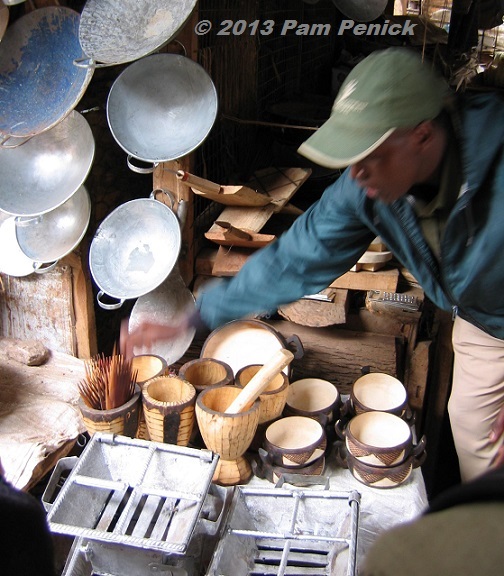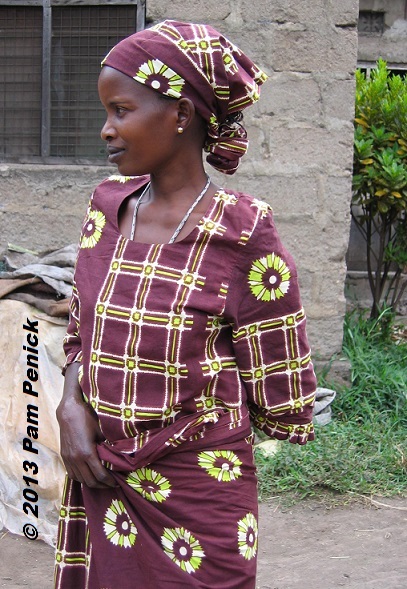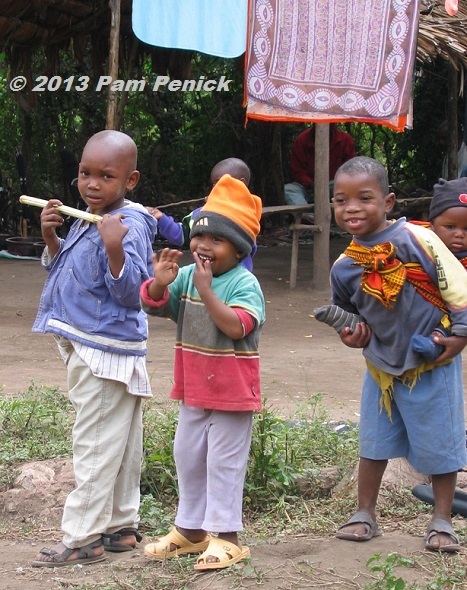Tanzanian safari: Mto Wa Mbu village
After the nature walk at the hotel, we drove down to the village of Mto wa Mbu, at the foot of the Rift Valley, for a guided tour (June 2007). Our guide told us that out of 120 tribal groups in Tanzania, 110 are represented by people living here. We visited the vegetable market first.

Then our guide showed us a kitchenware stall.
The village was busy, with people along the roadside selling produce and other goods. Homemade bridges — planks nailed to tree trunks — spanned a drainage ditch.
Along the road, women were selling bananas.
Near some houses, millet was spread out to dry.
Wattle and daub house. Mto Wa Mbu is one of the area’s wealthier villages thanks to an abundance of good cropland and spring water, our guide said, but it is still very poor by Western standards.

A young woman watching us nodded when I asked if I could photograph her. She chose to look away in a dignified manner, as most of the people did when they knew they were being photographed.

Children eating sugarcane
At one house, marigolds brightened the yard.
Women farming
Tauck had arranged for us to visit the home of a local woman, who was paid by our tour guide. Several buildings made up her courtyard home.
Here she is showing us her four cows, which she kept penned inside at all times — a practice called zero grazing.
Her goats were penned outdoors. She seemed proud to show us around, and I felt privileged to be invited into her home.
Up next: A game drive in Ngorongoro Crater, where we saw lions with a fresh kill and many other animals. For a look back at Lake Manyara National Park and a local school, click here.
All material © 2006-2014 by Pam Penick for Digging. Unauthorized reproduction prohibited.












The cows stay inside all the time? Don’t they need some sunshine for vitamin D? Maybe their pen isn’t totally covered.
You photos and commentary are wonderful.
I wondered about that too, Cheryl. Their indoor pen was completely enclosed. I’m glad you’re enjoying the series! —Pam
Heh.
What is wealth, anyway? Food, water, a roof, four walls.
Lovely textiles!
Wealth is definitely comparative. It was eye-opening for me — lucky enough to be born in a very wealthy country and to even be on such an expensive trip — to see what constitutes wealth in another part of the world. It makes you understand what’s really necessary: clean water, sufficient food, safety from crime and predatory animals, and, if you’re lucky, access to a doctor when you need it. —Pam
Wow, that is indeed a privilege! What beautiful people.
Yes, it was indeed. —Pam
I’m reminded by your post that I should go to the Kiva website, and relend some of the money that’s been paid back (most of my loans are to women farmers). Those bananas look delicious. I’m really enjoying this series of travel posts.
That sounds like an excellent cause, Alison. —Pam
Fascinating, Pam. I now have a special interest in that part of Africa, because our son – in – law, a senior officer in the Danish army, is the Danish Defense Attache to Kenya and Somalia. He took up his post in Nairobi a week before the shopping center bombing by al Shabab!
I hope he’ll have a chance to visit some of the natural treasures in Kenya while he’s there. I was reading Isak Dinesen during my trip — so much inspiration for a visit to Kenya. —Pam